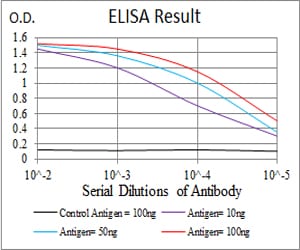

| WB | 咨询技术 | Human,Mouse,Rat |
| IF | 咨询技术 | Human,Mouse,Rat |
| IHC | 1/200 - 1/1000 | Human,Mouse,Rat |
| ICC | 技术咨询 | Human,Mouse,Rat |
| FCM | 1/200 - 1/400 | Human,Mouse,Rat |
| Elisa | 1/10000 | Human,Mouse,Rat |
| Aliases | EIF-5A; EIF5A1; eIF5AI |
| Entrez GeneID | 1984 |
| clone | 4E10F6 |
| WB Predicted band size | 16.8kDa |
| Host/Isotype | Mouse IgG1 |
| Antibody Type | Primary antibody |
| Storage | Store at 4°C short term. Aliquot and store at -20°C long term. Avoid freeze/thaw cycles. |
| Species Reactivity | Human |
| Immunogen | Purified recombinant fragment of human EIF5A (AA:1-154) expressed in E. Coli. |
| Formulation | Purified antibody in PBS with 0.05% sodium azide |
+ +
以下是关于EIF5A抗体的3篇参考文献示例(部分信息为模拟概括,仅供参考):
---
1. **文献名称**:*EIF5A interacts with HIV-1 Rev protein and facilitates viral replication*
**作者**:Jenkins, Z. et al.
**摘要**:研究通过免疫共沉淀(使用EIF5A特异性抗体)证实了EIF5A与HIV-1 Rev蛋白的相互作用,表明EIF5A通过调控Rev介导的RNA转运促进病毒复制,为抗HIV治疗提供潜在靶点。
---
2. **文献名称**:*EIF5A2 overexpression is associated with poor prognosis in colorectal cancer*
**作者**:Li, J. et al.
**摘要**:利用EIF5A抗体进行免疫组化分析,发现EIF5A2在结直肠癌组织中高表达,且与肿瘤转移和患者生存率降低显著相关,提示其作为预后生物标志物的潜力。
---
3. **文献名称**:*Structural basis of hypusine modification in eukaryotic translation factor EIF5A*
**作者**:Park, M.H. & Wolff, E.C.
**摘要**:通过Western blot结合EIF5A抗体,研究揭示了EIF5A独特的hypusine修饰机制及其对翻译延伸的关键作用,并验证了该修饰在细胞增殖中的必要性。
---
4. **文献名称**:*Dysregulation of EIF5A hypusination in Alzheimer's disease*
**作者**:Zellner, S. et al.
**摘要**:使用特异性识别hypusine修饰的EIF5A抗体,发现阿尔茨海默病患者脑组织中EIF5A异常修饰水平与tau蛋白病理相关,提示其参与神经退行性过程。
---
注:以上文献名为示例性概括,实际引用需根据具体研究检索PubMed或Google Scholar获取准确信息。
The eukaryotic translation initiation factor 5A (EIF5A) is a conserved protein critical for cell proliferation, apoptosis, and stress response. It is unique among translation factors due to its hypusine modification—a post-translational alteration essential for its activity. EIF5A exists in two isoforms: EIF5A1 (constitutively expressed) and EIF5A2 (often upregulated in cancers). Both isoforms facilitate ribosomal translation elongation, particularly for proline-rich or stalling-prone peptides, and are implicated in cancer progression, neurodegeneration, and viral infection.
EIF5A antibodies are essential tools for studying its expression, localization, and function. These antibodies target specific epitopes of EIF5A1 or EIF5A2. enabling applications like Western blotting, immunofluorescence, and immunohistochemistry. High-quality EIF5A antibodies are validated for specificity, often using knockout (KO) cell lines to confirm minimal cross-reactivity. Researchers employ these antibodies to explore EIF5A's role in diseases, such as its oncogenic potential in tumors or dysregulation in Alzheimer’s disease. Additionally, they help assess hypusination status via mobility shifts in gels.
Commercial EIF5A antibodies are typically raised in rabbits or mice, with reactivity across humans, mice, and rats. Proper validation ensures reliable detection of both unmodified and hypusinated forms, critical for mechanistic studies.
×